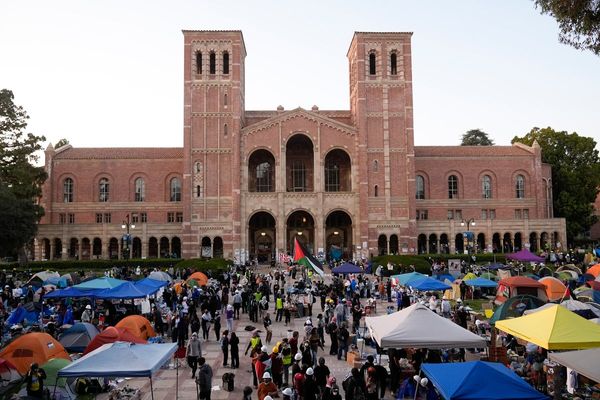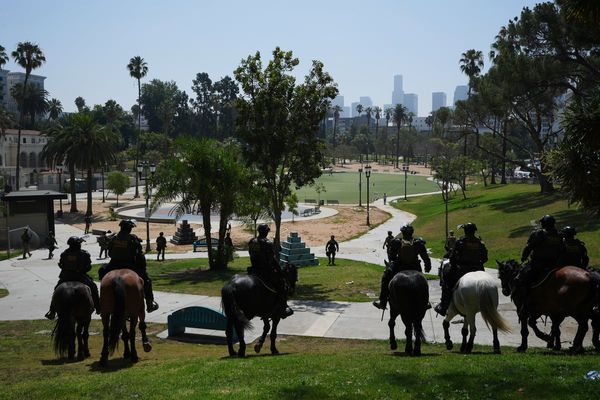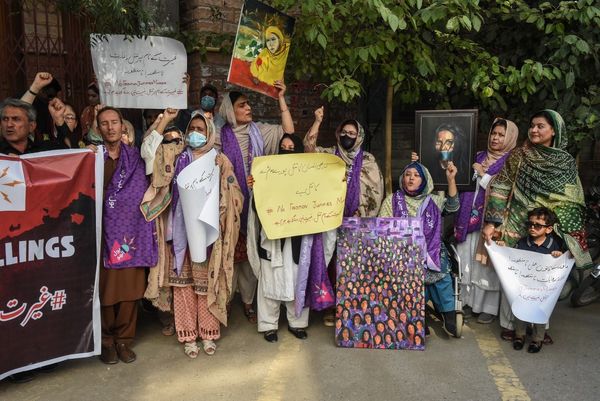
There are two garden sheds nestled on Lisa Ashdowne’s acreage home in the town of Pomonal in Victoria’s Grampians region. A large tarp hangs between them, forming a makeshift home decked out with a toilet, shower, sink, fridge and outside washing machine. “It’s tight and a bit awkward, but it’s home,” Ashdowne says.
The 62-year-old lost her house in the Pomonal fires in February 2024, just after separating from her partner and two weeks before she had a heart attack. She wasn’t adequately insured and says her casual work at a nearby prison does not provide enough money to pay for permanent accommodation elsewhere.
“I am back on my land, which I love,” she says. “It’s incredibly difficult. The land is still fairly parched. Our sandy soil and the reduced tree canopy means it is now very sparse. It feels a lot hotter.”
The first time Guardian Australia tries to speak to Ashdowne, it’s a 40C day in early December. There are fierce winds and an extreme fire rating in most parts of Victoria so she has to tend to her home and can’t talk. “I don’t find myself feeling consciously anxious but it does put the pressure on because everything feels like it’s dying again and all the hoses and taps are gone,” she says. “The other thing is, there is no one else here. It doesn’t feel like it used to feel. It’s strange.”
Late that month, her home is under threat again from a fire in the Grampians (Gariwerd) national park, which burned out of control for three weeks and moved across 76,000ha before it was contained in early January.
Ashdowne is one of hundreds of people in western Victoria living without a house in a bushfire-prone area. According to Victoria’s peak body for homelessness services, the Council to Homeless Persons (CHP), there were 2,049 people without a home in the region in 2022.
People experiencing homelessness in those areas are at risk, says the CHP chief executive, Deborah Di Natale, particularly with some regions, such as Gippsland, having no access to specialised outreach workers.
For the past two summers, the organisation has been calling on the Victorian government to boost assertive outreach in bushfire-prone regions. “We were lucky to avoid a catastrophe last summer,” Di Natale says. “We can’t risk it again this year.”
Without outreach workers, Di Natale says, it’s harder to warn vulnerable people about extreme or catastrophic fire days.
“Bushfires are a risk to entire communities but those dangers are even more severe for people sleeping rough, living in tents or cars,” she says. “These Victorians are more exposed to the elements and less connected to the community, which can make it harder to find and help them in the event of an emergency.”
According to a 2024 Anglicare rental affordability snapshot, only 5.3% of available rental properties in regional Victoria could be afforded by households relying on income support payments, and none were suitable for single people on jobseeker payments. Only 0.1% of properties were appropriate for single household types on an aged pension and 0.3% of properties were appropriate for families with two children on the jobseeker payment.
Di Natale says the Victorian government must address the statewide housing crisis. “The state needs to build at least 6,000 public and community homes, with regional areas included in that, each year, for a decade if we’re serious about tackling the housing crisis.”
The Victorian government did not respond to a request for comment.
‘We don’t know about everybody’
Jeremey Gunning lived in the Creswick state forest, 18km north of Ballarat, for 18 months. “Bushfires are a massive part of it, but there’s also flooding and frost and rain,” he says.
The support from Uniting Ballarat’s Street to Home outreach program was “absolutely brilliant,” the 52-year-old adds. “I feel indebted to Uniting and always will.”
Gunning now works as Uniting Ballarat’s first Street to Home homeless peer support worker.
But more funding is needed, he says. “[In early December] there was a bushfire in Creswick so we had to call the CFA and police because we had the locations of everyone we knew of. But we don’t know about everybody,” he says.
Funding for the Street to Home program beyond June isn’t guaranteed, says Uniting Vic Tas group manager of homelessness and community support Jerry Ham.
“Without funding for this program, it will put the lives of people experiencing homelessness across Ballarat and the Central Highlands at risk,” he says.
The program operates in six local government areas – Ballarat, Moorabool, Golden Plains, Hepburn, Ararat and Pyrenees. Since July, it has helped 148 people, including 10 children, into transitional and long-term accommodation.
“During extreme weather days, we contact people experiencing homelessness and where possible, offer crisis accommodation, and ensure they are able to access a radio, water, sunscreen, food, and can contact triple-0 if required,” Ham says.
The Foundation for Rural and Regional Renewal (FRRR) CEO, Natalie Egleton, says funding from business, philanthropy, governments and individuals is vital so local resources can be used to their full potential.
Egleton says local organisations understand the reality of each region and are best positioned to assist in the aftermath of an emergency.
“People who are already vulnerable and experiencing housing distress or homelessness are even more vulnerable when a fire happens,” she says. “They become invisible and it’s not always known who’s out there.
“The local organisations have the networks, knowledge, reach, relationships and trust but are often pushed to the side. They are there long before and long after a disaster. It comes down to advocating for those local organisations and their capability and capacity so they’re better equipped.”
Ashdowne agrees that local organisations, such as the local resilience group and Grampians Community Health, have been vital to the region’s survival, but are often overworked and understaffed.
“Our local resilience group became the centrepoint and did a lot of sourcing of emergency house rentals and accommodation but they can’t keep doing that,” she says. “They need to get back to their own lives.”







